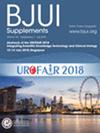前列腺癌局灶冷冻消融的新型MRI-US融合先进注释:中期结果和学习曲线见解。
IF 4.4
2区 医学
Q1 UROLOGY & NEPHROLOGY
引用次数: 0
摘要
目的评估使用新型三维高级标记平台(AAP)的磁共振成像-超声(MRI-US)融合引导局灶冷冻消融(FC)治疗局限性前列腺癌(PCa)患者的肿瘤和功能结果,并比较专家和初级外科医生的结果,以评估既往局灶治疗(FT)经验对FT结果的影响。患者和方法一项前瞻性单臂试验纳入了50名在2020年12月至2023年9月期间接受FC治疗的低至中危PCa男性患者。MRI-US融合引导的FC由两名具有不同FT经验的外科医生(bbb200 vs 0)使用UroNav AAP进行,其中19例由专家进行,31例由初级外科医生进行。随访包括前列腺特异性抗原,多参数MRI和1年的协议活检。主要终点是无失败生存期(FFS),定义为向根治性挽救治疗或全身治疗的过渡、PCa转移的发展或PCa特异性死亡。次要结局包括肿瘤控制和功能结局。进行事后分析以评估不同经验水平的外科医生的学习曲线和比较结果。结果2年FFS为96%(95%可信区间[CI] 90.7 ~ 100%)。1年的方案活检显示6%的场内(IFR)和12%的场外复发率(OFR)。3个月时尿功能完全恢复。在基线性健康量表评分≥17分的男性中,85%的男性在一年后勃起功能恢复,基线功能是一年后恢复的主要预测因素。所有并发症(26%)均为1-2级不良事件通用术语标准。不同外科医生的FC预后无显著差异。学习曲线主要表现为消融时间,每例减少1.44分钟(95% CI -1.98至-0.90),对冷冻探针数量(每例减少0.041分钟,95% CI -0.067至-0.014)和OFR率(每例减少0.014分钟,95% CI -0.028至-0.0003)的影响较小,但对IFR率和并发症没有影响。外科医生之间的学习模式没有差异。结论使用UroNav AAP的融合引导FC具有良好的肿瘤控制和安全性。该设备允许精确的MRI-US融合引导治疗,同时最大限度地减少专家和新手外科医生之间的学习曲线差异。本文章由计算机程序翻译,如有差异,请以英文原文为准。
Novel MRI-US fusion with advanced annotation in focal cryoablation for prostate cancer: medium-term outcomes and learning curve insights.
OBJECTIVES
To assess the oncological and functional outcomes of magnetic resonance imaging-ultrasonography (MRI-US) fusion-guided focal cryoablation (FC) using a novel three-dimensional Advanced Annotation Platform (AAP) in patients with localised prostate cancer (PCa) and compare results between expert and beginner surgeons to evaluate the impact of prior focal therapy (FT) experience on FT outcomes.
PATIENTS AND METHODS
A prospective single-arm trial enrolled 50 men with low- to intermediate-risk PCa who underwent FC between December 2020 and September 2023. MRI-US fusion-guided FC was performed using the UroNav AAP by two surgeons with different FT experience (>200 vs 0), with 19 cases carried out by an expert and 31 by a beginner surgeon. Follow-up included prostate-specific antigen, multiparametric MRI, and protocol biopsy at 1 year. The primary outcome was failure-free survival (FFS), defined as the transition to radical salvage treatment or to systemic therapy, development of PCa metastases, or PCa-specific death. Secondary outcomes included oncological control and functional outcomes. Post hoc analyses were performed to assess learning curves and compare outcomes between surgeons with different experience levels.
RESULTS
The 2-year FFS was 96% (95% confidence interval [CI] 90.7-100%). The 1-year protocol biopsy showed a 6% in-field (IFR) and 12% out-of-field recurrence (OFR) rates. Urinary function fully recovered at 3 months. Among men with baseline Sexual Health Inventory for Men score ≥17, 85% recovered erectile function at 1 year, with baseline function as the main predictor of recovery at 1 year. All complications (26%) were Common Terminology Criteria for Adverse Events Grade 1-2. There was no significant difference in FC outcomes between surgeons. Learning curves were demonstrated primarily for ablation time with a decrease of 1.44 min per case (95% CI -1.98 to -0.90), with small effects for number of cryoprobes (0.041 decrease per case, 95% CI -0.067 to -0.014) and OFR rate (0.014 decrease per case, 95% CI -0.028 to -0.0003), but not for the IFR rate and complications. No differences in learning patterns were observed between surgeons.
CONCLUSION
Fusion-guided FC using the UroNav AAP demonstrated good oncological control and safety profile. The device allowed precise MRI-US fusion-guided treatment while minimising the learning curve difference between expert and beginner surgeons.
求助全文
通过发布文献求助,成功后即可免费获取论文全文。
去求助
来源期刊

BJU International
医学-泌尿学与肾脏学
CiteScore
9.10
自引率
4.40%
发文量
262
审稿时长
1 months
期刊介绍:
BJUI is one of the most highly respected medical journals in the world, with a truly international range of published papers and appeal. Every issue gives invaluable practical information in the form of original articles, reviews, comments, surgical education articles, and translational science articles in the field of urology. BJUI employs topical sections, and is in full colour, making it easier to browse or search for something specific.
 求助内容:
求助内容: 应助结果提醒方式:
应助结果提醒方式:


